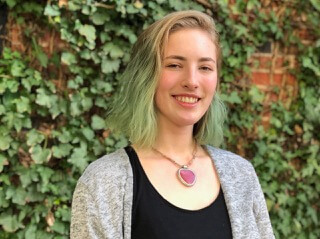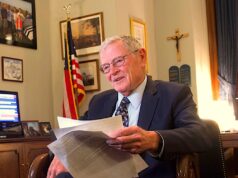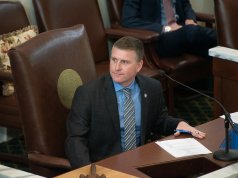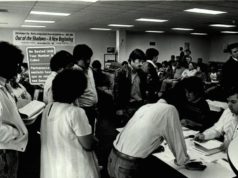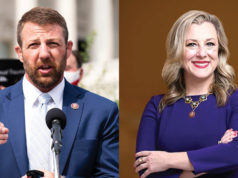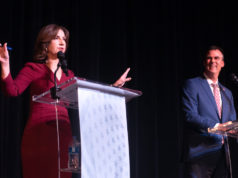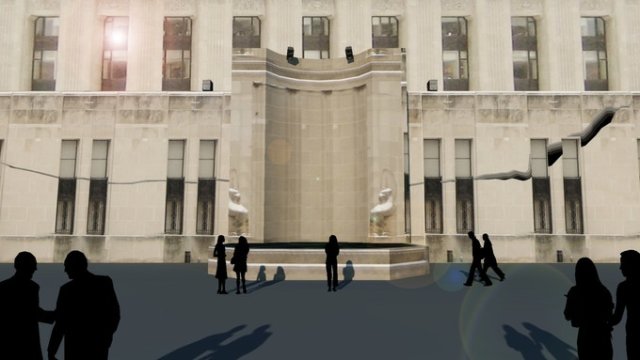

Just weeks ago, roughly 30,000 people a day were able to experience the sight and sounds of a breaking arctic glacier. They weren’t anywhere near the poles, however.
Thanks to a massive art installation at Chicago’s Riverside Plaza, visitors to the Windy City could view a scaled version of a crack in the Larsen C ice shelf on the side of a building. A soundtrack of creaking and cracking ice accompanied the visual, creating a jarring depiction of the effects of climate change.
The artists behind this environmental public art are part of a collaboration called Luftwerk. They hoped to help people better understand how climate change sounds and looks, according to Petra Bachmaier, one of the artists.
The effort is just one of many in recent years in which concerned artists use their platform to bring awareness to environmental issues. With recent developments making these issues more pressing for those concerned, now is a better time than ever for artists to step in and draw attention to them — especially in Oklahoma.
A history of denial
As a state, Oklahoma tends to have a less accepting attitude toward climate issues than other parts of the U.S. A Yale study shows that Oklahomans are overall less concerned about the issue of climate change and less trustful of climate scientists compared to the national average.
“[Climate change] has become really polarizing, I’d say especially over the past five years, where we start to see people embracing and expressing values at really opposite ends of the spectrum,” said Jessica Beyer, a researcher and environmental studies professor at the University of Oklahoma.
Perhaps most famously, Oklahoma Sen. James Inhofe argued in 2015 against man-made climate change by bringing a snowball into the Senate. Although he acknowledged that the climate could fluctuate, “the hoax is that there are people who are so arrogant that they think they have the power to change climate,” Inhofe said at the time.
This skepticism about climate science translates to legislation about Oklahoma public schools as well. Senate Bill 393, introduced earlier this year, would allow educators in Oklahoma public schools to teach climate change as a controversial topic if passed. Iterations of this bill have been introduced more than three times before.
Despite its hesitance to accept climate science, the effects of climate change will impact Oklahoma notably, according to a 2016 fact sheet from the Environmental Protection Agency. Associated lack of water and higher temperatures are predicted to pose problems for agriculture and ranching, both of which are important in Oklahoma.
Clearly, although Oklahoma has a lot going for it (we are one of the nation’s leaders in wind power) the state could benefit from a broader conversation about environmental issues. But if some people refuse to listen to scientists, who will start this conversation?
We need more environmental public art
This is where environmental public art comes in. Installations like the one in Chicago have been popping up all over the U.S. in recent years. Such public art displays in Tulsa or Oklahoma City might also help spark a dialogue about environmental concerns.
Professor Beyer at OU has collaborated with her mother-in-law, artist Carolyn Halliday, in the past to bring awareness of environmental issues to people with Halliday’s fiber art, she said. She’s found that use of art draws interest in a way that science often cannot. It especially fascinates children.
“I’ve done outreach related to my science and I’ve done outreach related to this artwork, and students especially, like younger children [in] elementary school, really get into the art stuff,” Beyer said.
Some arts organizations in Oklahoma do encourage environmental friendliness as part of their platforms. The Oklahoma City Arts Council’s yearly Festival of the Arts encourages carpooling as a way for festival-goers to lower air pollution, while Indigo Fest also attempts to be a zero-carbon footprint event, requiring visitors to take all non-compostable and non-recyclable items they bring into the festival out with them again.
‘This overlap between science and art’
Organizational and event-based efforts aside, environmental public art might be the best way for people to visualize the effects of real scientific processes happening around them.
“There’s a lot of really cool work in this overlap between science and art, trying to communicate findings of science in a way that’s maybe more approachable or more concrete than somebody standing up with a PowerPoint presentation and showing data,” Beyer said. “If you can interact either physically or be in the same space with the art, I think it makes it feel a little bit more real.”









